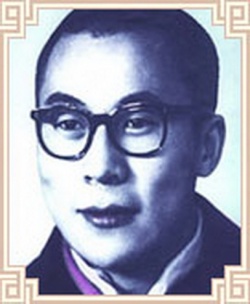Dalai Lama in His Youth
On the day before the opera festival in the summer of 1950, His Holiness was just coming out of the bathroom at the Norbulingka when he felt the earth beneath begin to move. As the scale of this natural phenomenon began to sink in, people naturally began to say that this was more than a simple earthquake: it was an omen.
Two days later, Regent Tatra received a telegram from the Governor of Kham, based in Chamdo, reporting a raid on a Tibetan post by Chinese soldiers. Already the previous autumn there had been cross-border incursions by Chinese Communists, who stated their intention of liberating Tibet from the hands of imperialist aggressors. “It now looked as if the Chinese were making good their threat. If that were so, I was well aware that Tibet was in grave danger for our army comprised no more than 8,500 officers and men. It would be no match for the recently victorious People's Liberation Army (PLA)”.
Two months later, in October, news reached Lhasa that an army of 80,000 soldiers of the People’s Liberation Army had crossed the Drichu river east of Chamdo. So the axe had fallen. And soon, Lhasa would have to fall. As the winter drew on and the news got worse, people began to advocate that His Holiness be given his full temporal (political) power. At a ceremony, the Government consulted the Nechung Oracle, a very tense moment, who came over to where His Holiness was seated and laid a kata, a white offering scarf, on His Holiness's lap with the words thu-la bap, his time has come. Thus, at the young age of fifteen, His Holiness was on 17 November 1950 officially enthroned as the temporal leader of Tibet in a ceremony held at the Norbulingka Palace.
At the beginning of November, about a fortnight before the day of His Holiness's investiture, his eldest brother arrived in Lhasa. “As soon as I set eyes on him, I knew that he had suffered greatly. Because Amdo, the province where we were both born, and in which Kumbum is situated, lies so close to China, it had quickly fallen under control of the Communists. He himself was kept virtual prisoner in his monastery. At the same time, the Chinese endeavored to indoctrinate him in the new Communist way of thinking and tried to subvert him. They had a plan whereby they would set him free to go to Lhasa if he would undertake to persuade me to accept Chinese rule. If I resisted, he was to kill me. They would then reward him”.
To mark the occasion of his ascension to power, His Holiness granted a general amnesty whereby all the prisoners were set free.
Shortly after the 15-year-old Dalai Lama found himself the undisputed leader of six million people facing the threat of a full-scale war, His Holiness appointed two new Prime Ministers. Lobsang Tashi became the monk Prime Minister and an experienced lay administrator, Lukhangwa, the lay Prime Minister.
Then in consultation with the two Prime Ministers and the Kashag, His Holiness decided to send delegations abroad to America, Great Britain and Nepal in the hope of persuading these countries to intervene on Tibet’s behalf. Another was to go to China in the hope of negotiating a withdrawal. These missions left towards the end of the year. “Shortly afterwards, with the Chinese consolidating their forces in the east, we decided that I should move to southern Tibet with the most senior members of the Government. That way, if the situation deteriorated, I could easily seek exile across the border with India. Meanwhile, Lobsang Tashi and Lunkhangwa were to remain in an acting capacity”.
While His Holiness was in Dromo, which lay just inside the border with Sikkim, he received the news that while the delegation to China had reached its destination, each of the others had been turned back. It was almost impossible to believe that the British Government was now agreeing that China had some claim to authority over Tibet. His Holiness was equally saddened by America's reluctance to help. “I remember feeling great sorrow when I realized what this really meant: Tibet must expect to face the entire might of Communist China alone”.
Frustrated by the indifference shown to Tibet's case by Great Britain and America, His Holiness, in his last bid to avoid a full-scale Chinese invasion, sent Ngabo Ngawang Jigme, governor of Kham, to Beijing to open a dialogue with the Chinese. The delegation hadn't been given the power to reach at any settlement, apart from its entrusted task of convincing the Chinese leadership against invading Tibet. However, one evening, as His Holiness sat alone, a harsh, crackling voice on the radio announced that a Seventeen-Point 'Agreement' for the Peaceful Liberation of Tibet had that day (23 May 1951) been signed by representatives of the Government of the People's Republic of China and what they called the Local Government of Tibet. As it turned out, the Chinese who even forged the Tibetan seal had forced the delegation headed by Ngabo into signing the agreement. The Chinese had in effect secured a major coup by winning Tibetan compliance, albeit at gunpoint, to their terms of returning Tibet to the fold of the motherland. His Holiness returned to Lhasa in the middle of August 1951.
